Strategic Management Analysis of Woolworths: A Comprehensive Report
VerifiedAdded on 2023/01/23
|20
|4564
|70
Report
AI Summary
This report provides an in-depth analysis of the strategic management of Woolworths, a major Australian retailer. It begins with a company overview and identifies key resources and capabilities, assessing their competitive power using the VRIN test. The report then examines Woolworths' competitive environment through Porter's five forces framework, evaluating factors like competitive rivalry, supplier power, buyer power, the threat of new entrants, and the threat of substitutes. Based on this analysis, the report discusses the most appropriate generic strategies for Woolworths. Furthermore, it critically evaluates the strategic components of leadership and staffing, considering their alignment with the recommended strategy. The report concludes with recommendations for the company's strategic direction.
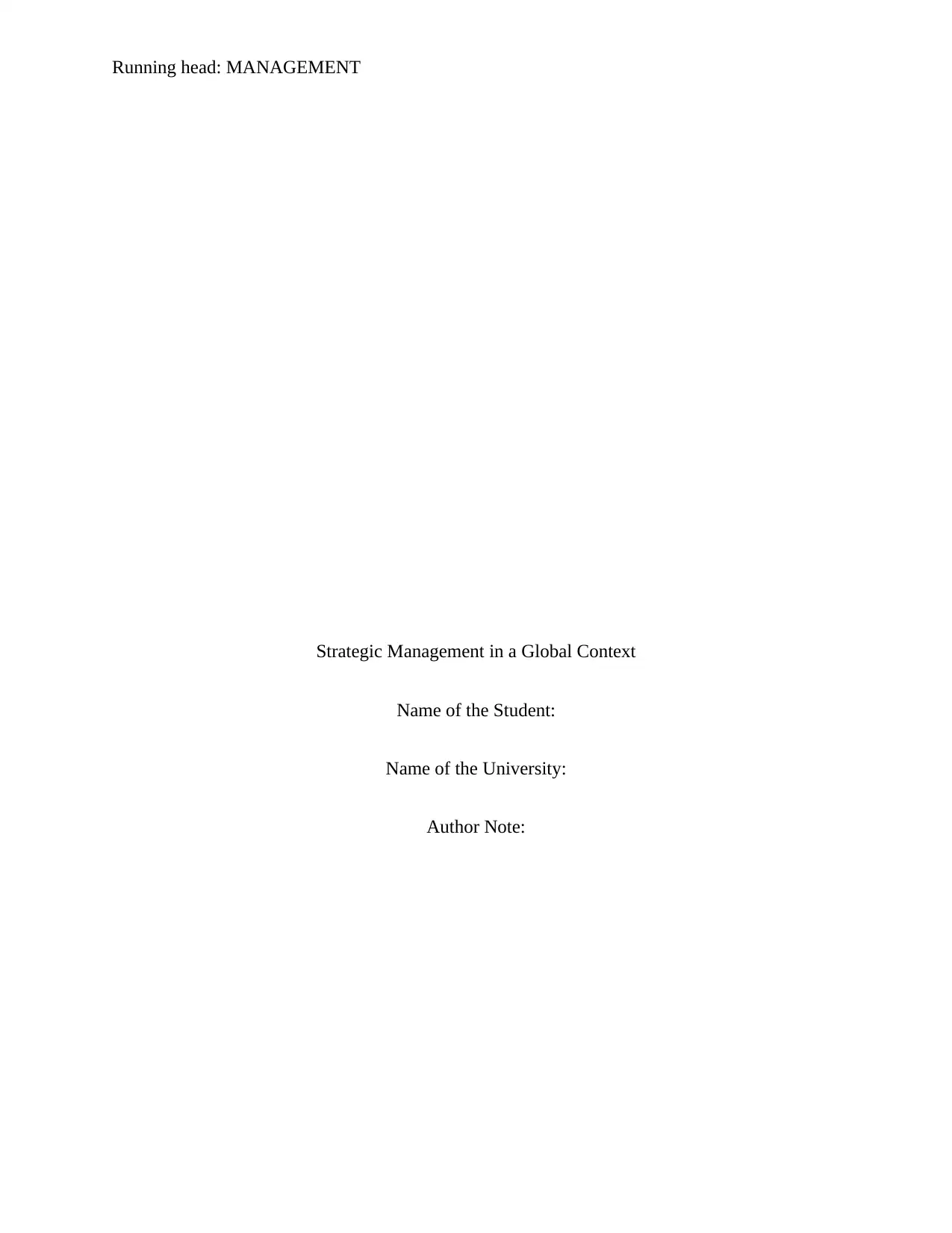
Running head: MANAGEMENT
Strategic Management in a Global Context
Name of the Student:
Name of the University:
Author Note:
Strategic Management in a Global Context
Name of the Student:
Name of the University:
Author Note:
Paraphrase This Document
Need a fresh take? Get an instant paraphrase of this document with our AI Paraphraser
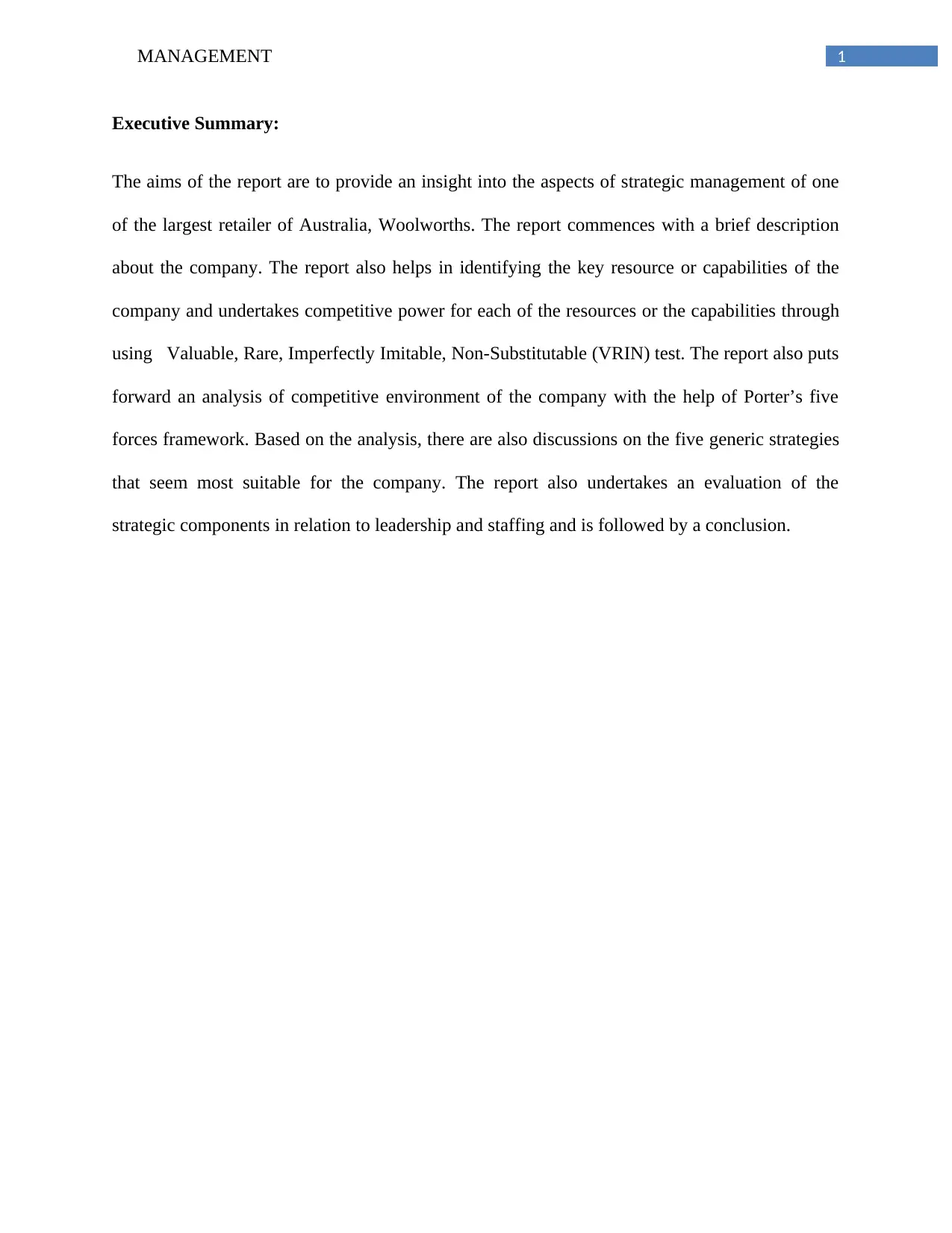
1MANAGEMENT
Executive Summary:
The aims of the report are to provide an insight into the aspects of strategic management of one
of the largest retailer of Australia, Woolworths. The report commences with a brief description
about the company. The report also helps in identifying the key resource or capabilities of the
company and undertakes competitive power for each of the resources or the capabilities through
using Valuable, Rare, Imperfectly Imitable, Non-Substitutable (VRIN) test. The report also puts
forward an analysis of competitive environment of the company with the help of Porter’s five
forces framework. Based on the analysis, there are also discussions on the five generic strategies
that seem most suitable for the company. The report also undertakes an evaluation of the
strategic components in relation to leadership and staffing and is followed by a conclusion.
Executive Summary:
The aims of the report are to provide an insight into the aspects of strategic management of one
of the largest retailer of Australia, Woolworths. The report commences with a brief description
about the company. The report also helps in identifying the key resource or capabilities of the
company and undertakes competitive power for each of the resources or the capabilities through
using Valuable, Rare, Imperfectly Imitable, Non-Substitutable (VRIN) test. The report also puts
forward an analysis of competitive environment of the company with the help of Porter’s five
forces framework. Based on the analysis, there are also discussions on the five generic strategies
that seem most suitable for the company. The report also undertakes an evaluation of the
strategic components in relation to leadership and staffing and is followed by a conclusion.
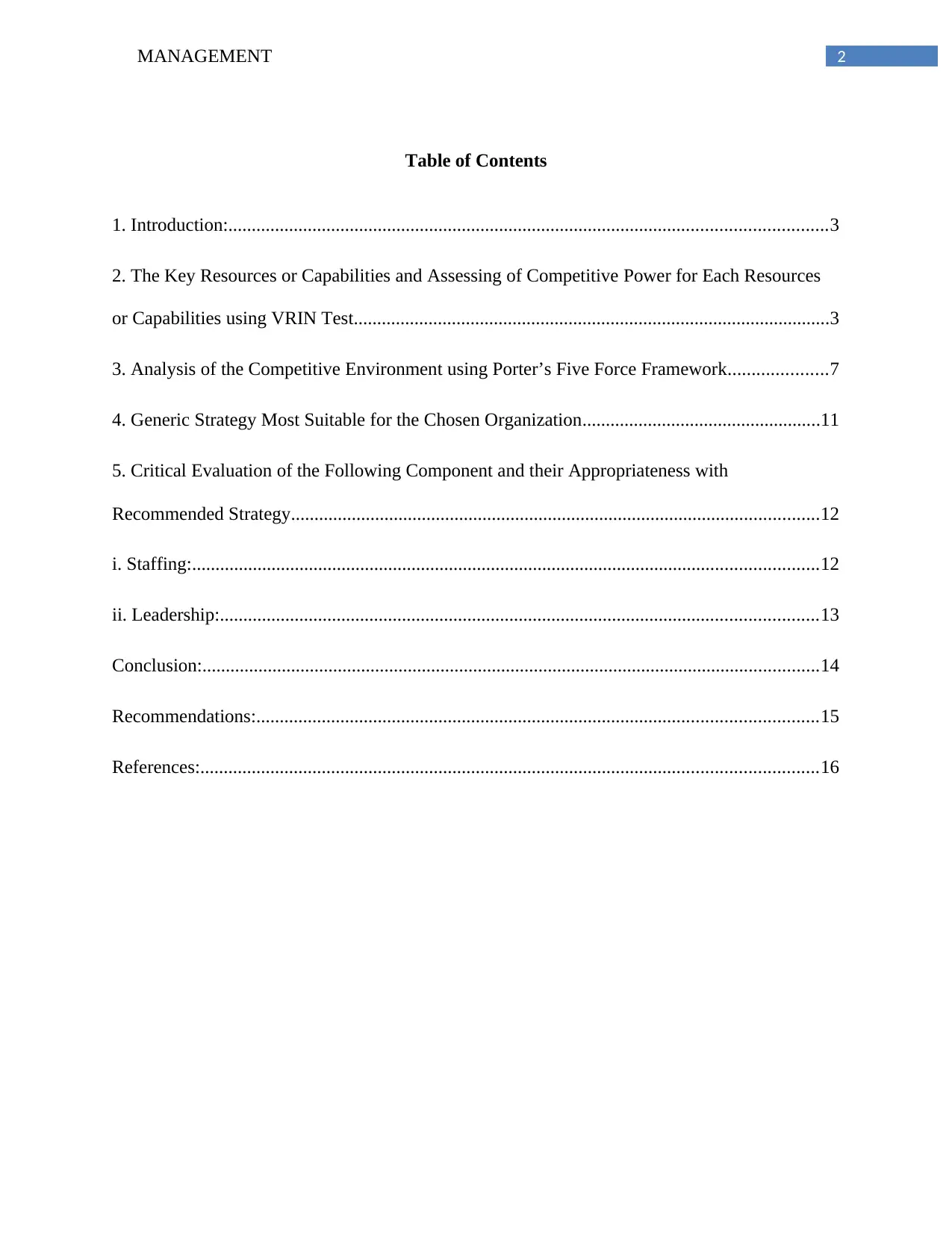
2MANAGEMENT
Table of Contents
1. Introduction:................................................................................................................................3
2. The Key Resources or Capabilities and Assessing of Competitive Power for Each Resources
or Capabilities using VRIN Test......................................................................................................3
3. Analysis of the Competitive Environment using Porter’s Five Force Framework.....................7
4. Generic Strategy Most Suitable for the Chosen Organization...................................................11
5. Critical Evaluation of the Following Component and their Appropriateness with
Recommended Strategy.................................................................................................................12
i. Staffing:......................................................................................................................................12
ii. Leadership:................................................................................................................................13
Conclusion:....................................................................................................................................14
Recommendations:........................................................................................................................15
References:....................................................................................................................................16
Table of Contents
1. Introduction:................................................................................................................................3
2. The Key Resources or Capabilities and Assessing of Competitive Power for Each Resources
or Capabilities using VRIN Test......................................................................................................3
3. Analysis of the Competitive Environment using Porter’s Five Force Framework.....................7
4. Generic Strategy Most Suitable for the Chosen Organization...................................................11
5. Critical Evaluation of the Following Component and their Appropriateness with
Recommended Strategy.................................................................................................................12
i. Staffing:......................................................................................................................................12
ii. Leadership:................................................................................................................................13
Conclusion:....................................................................................................................................14
Recommendations:........................................................................................................................15
References:....................................................................................................................................16
⊘ This is a preview!⊘
Do you want full access?
Subscribe today to unlock all pages.

Trusted by 1+ million students worldwide
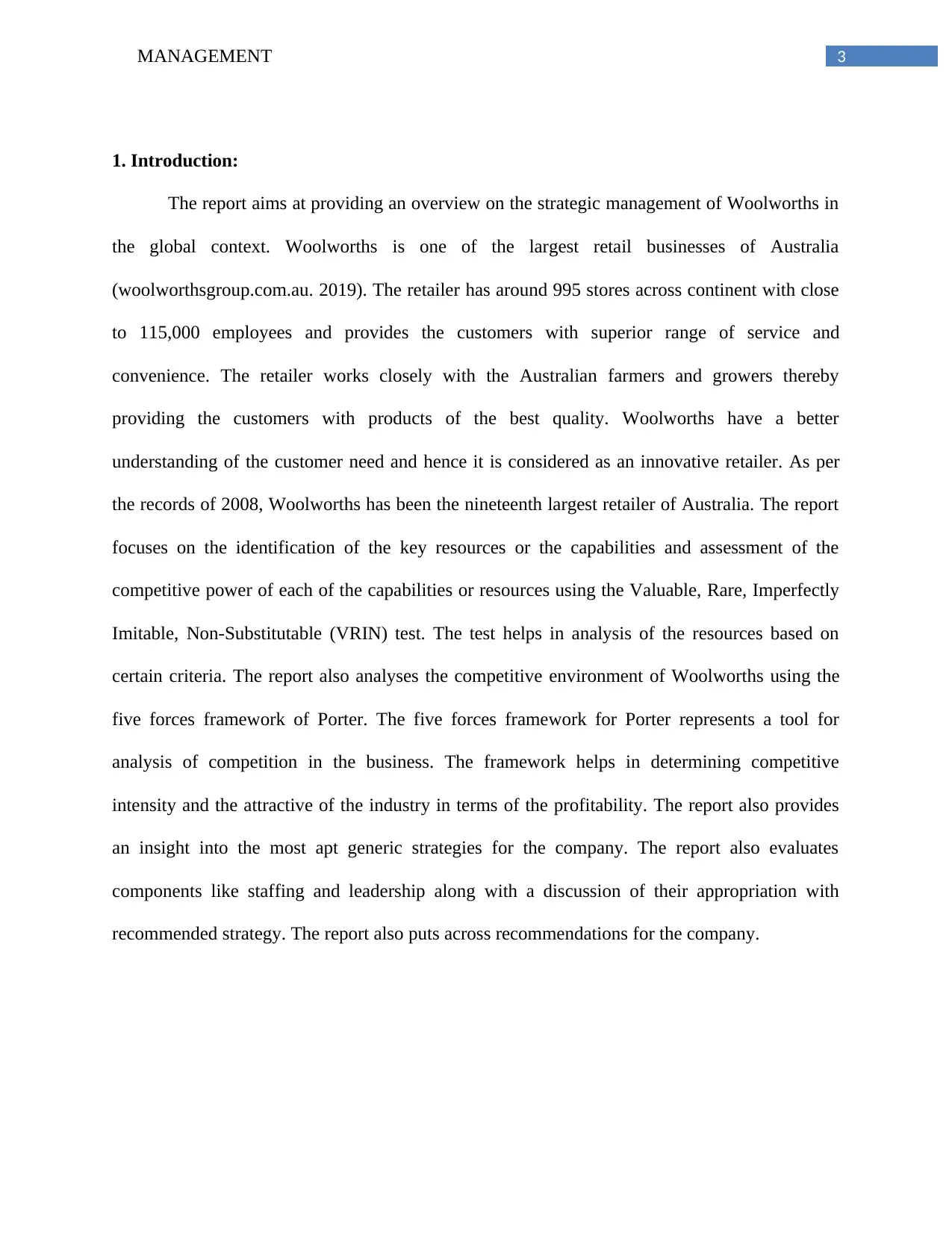
3MANAGEMENT
1. Introduction:
The report aims at providing an overview on the strategic management of Woolworths in
the global context. Woolworths is one of the largest retail businesses of Australia
(woolworthsgroup.com.au. 2019). The retailer has around 995 stores across continent with close
to 115,000 employees and provides the customers with superior range of service and
convenience. The retailer works closely with the Australian farmers and growers thereby
providing the customers with products of the best quality. Woolworths have a better
understanding of the customer need and hence it is considered as an innovative retailer. As per
the records of 2008, Woolworths has been the nineteenth largest retailer of Australia. The report
focuses on the identification of the key resources or the capabilities and assessment of the
competitive power of each of the capabilities or resources using the Valuable, Rare, Imperfectly
Imitable, Non-Substitutable (VRIN) test. The test helps in analysis of the resources based on
certain criteria. The report also analyses the competitive environment of Woolworths using the
five forces framework of Porter. The five forces framework for Porter represents a tool for
analysis of competition in the business. The framework helps in determining competitive
intensity and the attractive of the industry in terms of the profitability. The report also provides
an insight into the most apt generic strategies for the company. The report also evaluates
components like staffing and leadership along with a discussion of their appropriation with
recommended strategy. The report also puts across recommendations for the company.
1. Introduction:
The report aims at providing an overview on the strategic management of Woolworths in
the global context. Woolworths is one of the largest retail businesses of Australia
(woolworthsgroup.com.au. 2019). The retailer has around 995 stores across continent with close
to 115,000 employees and provides the customers with superior range of service and
convenience. The retailer works closely with the Australian farmers and growers thereby
providing the customers with products of the best quality. Woolworths have a better
understanding of the customer need and hence it is considered as an innovative retailer. As per
the records of 2008, Woolworths has been the nineteenth largest retailer of Australia. The report
focuses on the identification of the key resources or the capabilities and assessment of the
competitive power of each of the capabilities or resources using the Valuable, Rare, Imperfectly
Imitable, Non-Substitutable (VRIN) test. The test helps in analysis of the resources based on
certain criteria. The report also analyses the competitive environment of Woolworths using the
five forces framework of Porter. The five forces framework for Porter represents a tool for
analysis of competition in the business. The framework helps in determining competitive
intensity and the attractive of the industry in terms of the profitability. The report also provides
an insight into the most apt generic strategies for the company. The report also evaluates
components like staffing and leadership along with a discussion of their appropriation with
recommended strategy. The report also puts across recommendations for the company.
Paraphrase This Document
Need a fresh take? Get an instant paraphrase of this document with our AI Paraphraser
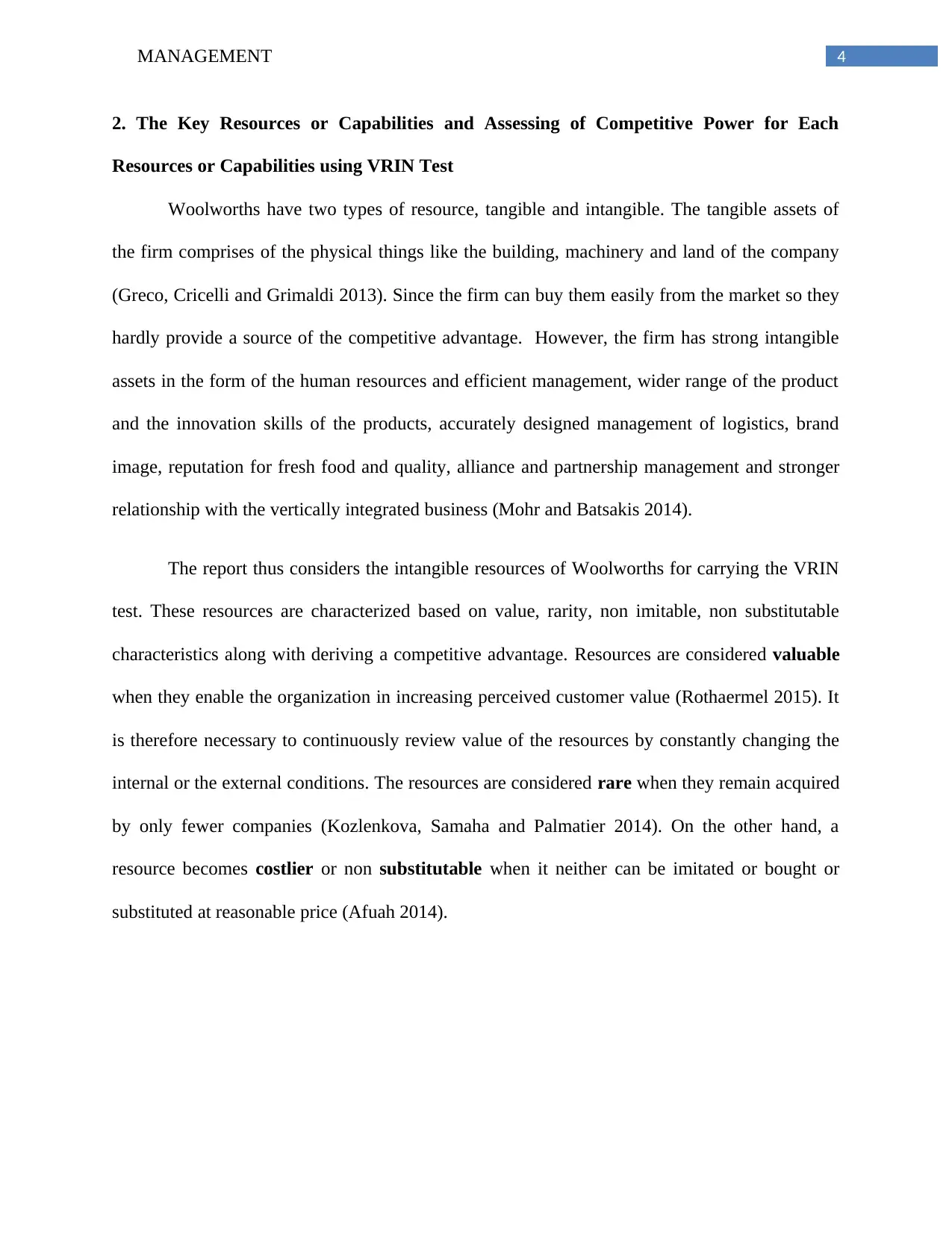
4MANAGEMENT
2. The Key Resources or Capabilities and Assessing of Competitive Power for Each
Resources or Capabilities using VRIN Test
Woolworths have two types of resource, tangible and intangible. The tangible assets of
the firm comprises of the physical things like the building, machinery and land of the company
(Greco, Cricelli and Grimaldi 2013). Since the firm can buy them easily from the market so they
hardly provide a source of the competitive advantage. However, the firm has strong intangible
assets in the form of the human resources and efficient management, wider range of the product
and the innovation skills of the products, accurately designed management of logistics, brand
image, reputation for fresh food and quality, alliance and partnership management and stronger
relationship with the vertically integrated business (Mohr and Batsakis 2014).
The report thus considers the intangible resources of Woolworths for carrying the VRIN
test. These resources are characterized based on value, rarity, non imitable, non substitutable
characteristics along with deriving a competitive advantage. Resources are considered valuable
when they enable the organization in increasing perceived customer value (Rothaermel 2015). It
is therefore necessary to continuously review value of the resources by constantly changing the
internal or the external conditions. The resources are considered rare when they remain acquired
by only fewer companies (Kozlenkova, Samaha and Palmatier 2014). On the other hand, a
resource becomes costlier or non substitutable when it neither can be imitated or bought or
substituted at reasonable price (Afuah 2014).
2. The Key Resources or Capabilities and Assessing of Competitive Power for Each
Resources or Capabilities using VRIN Test
Woolworths have two types of resource, tangible and intangible. The tangible assets of
the firm comprises of the physical things like the building, machinery and land of the company
(Greco, Cricelli and Grimaldi 2013). Since the firm can buy them easily from the market so they
hardly provide a source of the competitive advantage. However, the firm has strong intangible
assets in the form of the human resources and efficient management, wider range of the product
and the innovation skills of the products, accurately designed management of logistics, brand
image, reputation for fresh food and quality, alliance and partnership management and stronger
relationship with the vertically integrated business (Mohr and Batsakis 2014).
The report thus considers the intangible resources of Woolworths for carrying the VRIN
test. These resources are characterized based on value, rarity, non imitable, non substitutable
characteristics along with deriving a competitive advantage. Resources are considered valuable
when they enable the organization in increasing perceived customer value (Rothaermel 2015). It
is therefore necessary to continuously review value of the resources by constantly changing the
internal or the external conditions. The resources are considered rare when they remain acquired
by only fewer companies (Kozlenkova, Samaha and Palmatier 2014). On the other hand, a
resource becomes costlier or non substitutable when it neither can be imitated or bought or
substituted at reasonable price (Afuah 2014).
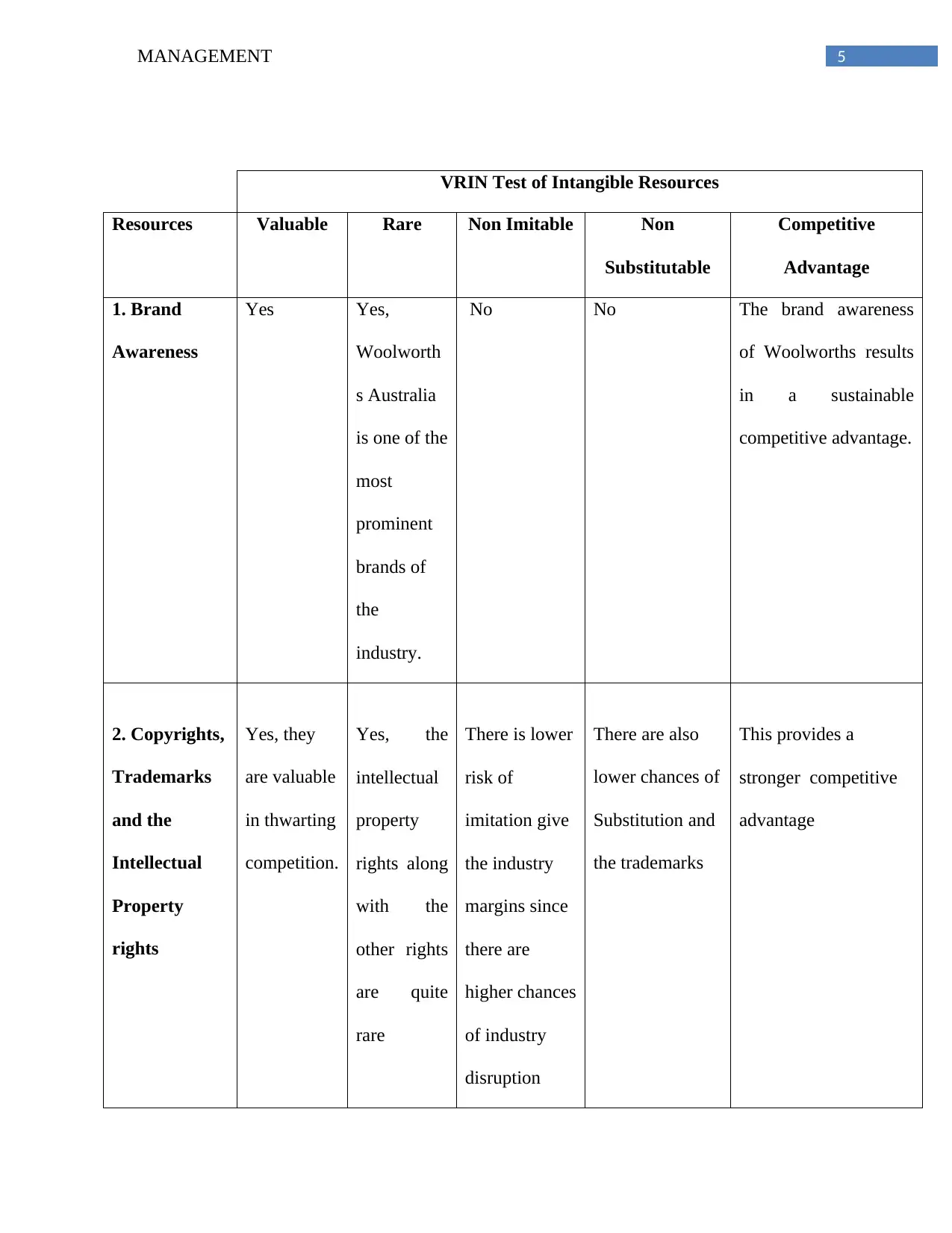
5MANAGEMENT
VRIN Test of Intangible Resources
Resources Valuable Rare Non Imitable Non
Substitutable
Competitive
Advantage
1. Brand
Awareness
Yes Yes,
Woolworth
s Australia
is one of the
most
prominent
brands of
the
industry.
No No The brand awareness
of Woolworths results
in a sustainable
competitive advantage.
2. Copyrights,
Trademarks
and the
Intellectual
Property
rights
Yes, they
are valuable
in thwarting
competition.
Yes, the
intellectual
property
rights along
with the
other rights
are quite
rare
There is lower
risk of
imitation give
the industry
margins since
there are
higher chances
of industry
disruption
There are also
lower chances of
Substitution and
the trademarks
This provides a
stronger competitive
advantage
VRIN Test of Intangible Resources
Resources Valuable Rare Non Imitable Non
Substitutable
Competitive
Advantage
1. Brand
Awareness
Yes Yes,
Woolworth
s Australia
is one of the
most
prominent
brands of
the
industry.
No No The brand awareness
of Woolworths results
in a sustainable
competitive advantage.
2. Copyrights,
Trademarks
and the
Intellectual
Property
rights
Yes, they
are valuable
in thwarting
competition.
Yes, the
intellectual
property
rights along
with the
other rights
are quite
rare
There is lower
risk of
imitation give
the industry
margins since
there are
higher chances
of industry
disruption
There are also
lower chances of
Substitution and
the trademarks
This provides a
stronger competitive
advantage
⊘ This is a preview!⊘
Do you want full access?
Subscribe today to unlock all pages.

Trusted by 1+ million students worldwide
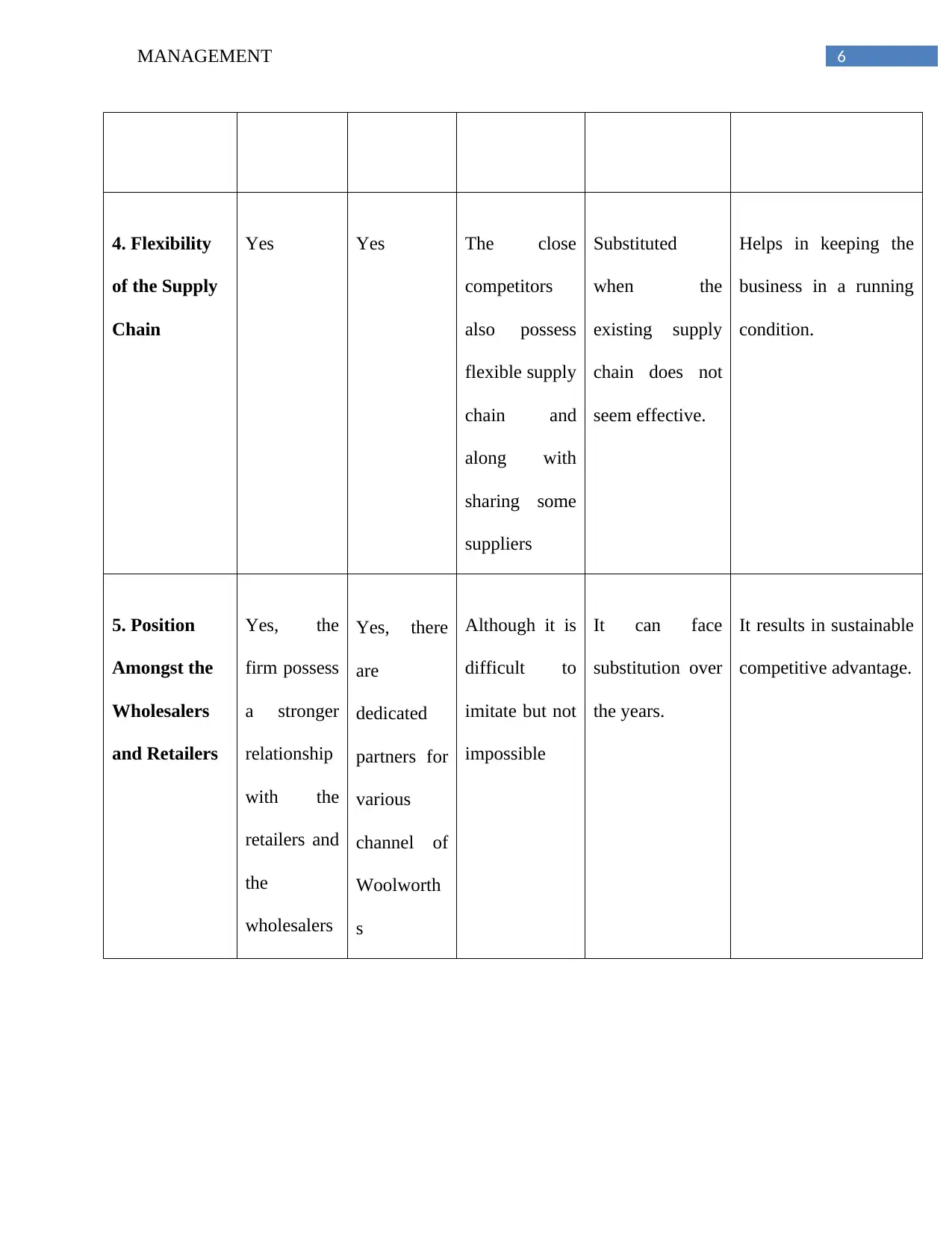
6MANAGEMENT
4. Flexibility
of the Supply
Chain
Yes Yes The close
competitors
also possess
flexible supply
chain and
along with
sharing some
suppliers
Substituted
when the
existing supply
chain does not
seem effective.
Helps in keeping the
business in a running
condition.
5. Position
Amongst the
Wholesalers
and Retailers
Yes, the
firm possess
a stronger
relationship
with the
retailers and
the
wholesalers
Yes, there
are
dedicated
partners for
various
channel of
Woolworth
s
Although it is
difficult to
imitate but not
impossible
It can face
substitution over
the years.
It results in sustainable
competitive advantage.
4. Flexibility
of the Supply
Chain
Yes Yes The close
competitors
also possess
flexible supply
chain and
along with
sharing some
suppliers
Substituted
when the
existing supply
chain does not
seem effective.
Helps in keeping the
business in a running
condition.
5. Position
Amongst the
Wholesalers
and Retailers
Yes, the
firm possess
a stronger
relationship
with the
retailers and
the
wholesalers
Yes, there
are
dedicated
partners for
various
channel of
Woolworth
s
Although it is
difficult to
imitate but not
impossible
It can face
substitution over
the years.
It results in sustainable
competitive advantage.
Paraphrase This Document
Need a fresh take? Get an instant paraphrase of this document with our AI Paraphraser
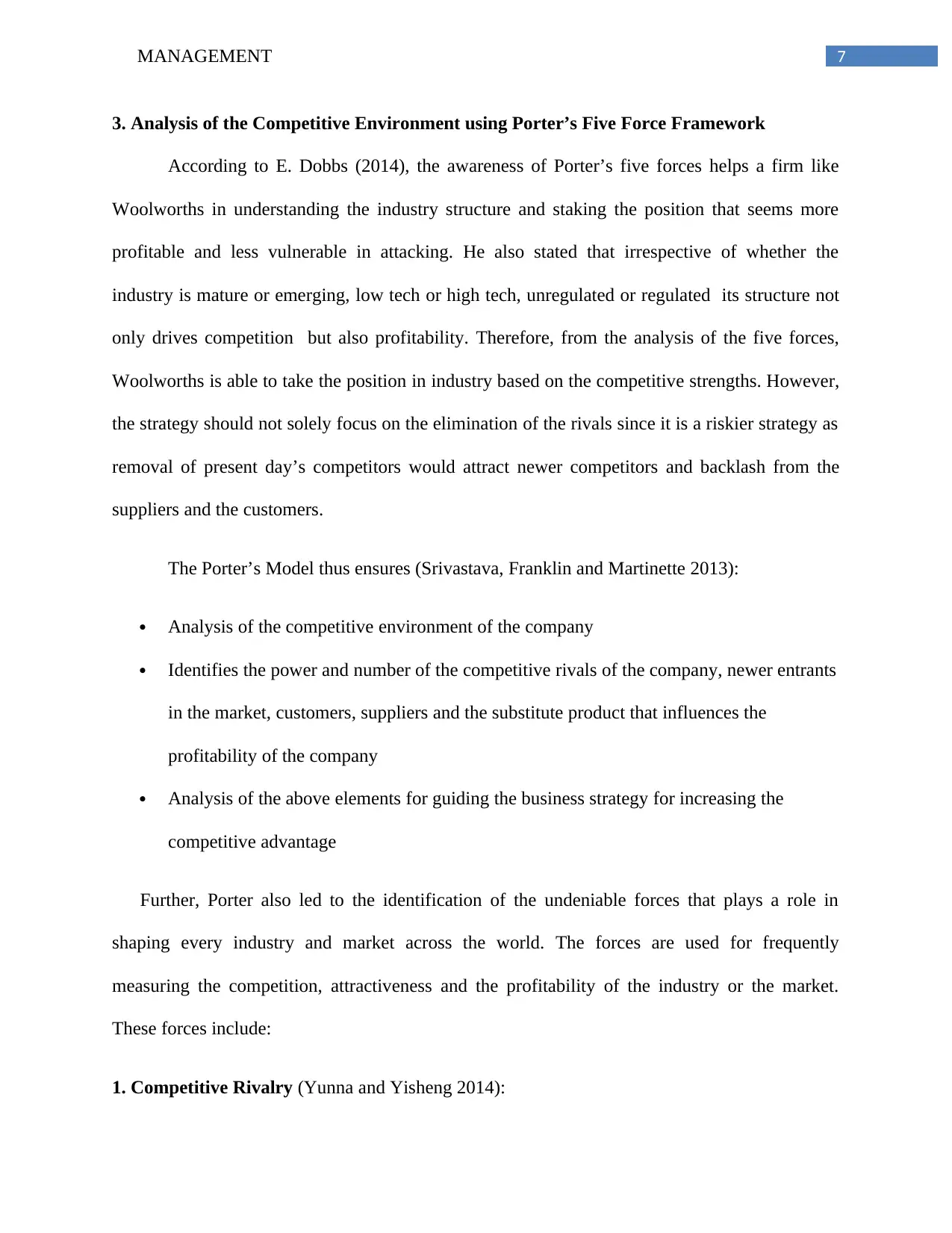
7MANAGEMENT
3. Analysis of the Competitive Environment using Porter’s Five Force Framework
According to E. Dobbs (2014), the awareness of Porter’s five forces helps a firm like
Woolworths in understanding the industry structure and staking the position that seems more
profitable and less vulnerable in attacking. He also stated that irrespective of whether the
industry is mature or emerging, low tech or high tech, unregulated or regulated its structure not
only drives competition but also profitability. Therefore, from the analysis of the five forces,
Woolworths is able to take the position in industry based on the competitive strengths. However,
the strategy should not solely focus on the elimination of the rivals since it is a riskier strategy as
removal of present day’s competitors would attract newer competitors and backlash from the
suppliers and the customers.
The Porter’s Model thus ensures (Srivastava, Franklin and Martinette 2013):
Analysis of the competitive environment of the company
Identifies the power and number of the competitive rivals of the company, newer entrants
in the market, customers, suppliers and the substitute product that influences the
profitability of the company
Analysis of the above elements for guiding the business strategy for increasing the
competitive advantage
Further, Porter also led to the identification of the undeniable forces that plays a role in
shaping every industry and market across the world. The forces are used for frequently
measuring the competition, attractiveness and the profitability of the industry or the market.
These forces include:
1. Competitive Rivalry (Yunna and Yisheng 2014):
3. Analysis of the Competitive Environment using Porter’s Five Force Framework
According to E. Dobbs (2014), the awareness of Porter’s five forces helps a firm like
Woolworths in understanding the industry structure and staking the position that seems more
profitable and less vulnerable in attacking. He also stated that irrespective of whether the
industry is mature or emerging, low tech or high tech, unregulated or regulated its structure not
only drives competition but also profitability. Therefore, from the analysis of the five forces,
Woolworths is able to take the position in industry based on the competitive strengths. However,
the strategy should not solely focus on the elimination of the rivals since it is a riskier strategy as
removal of present day’s competitors would attract newer competitors and backlash from the
suppliers and the customers.
The Porter’s Model thus ensures (Srivastava, Franklin and Martinette 2013):
Analysis of the competitive environment of the company
Identifies the power and number of the competitive rivals of the company, newer entrants
in the market, customers, suppliers and the substitute product that influences the
profitability of the company
Analysis of the above elements for guiding the business strategy for increasing the
competitive advantage
Further, Porter also led to the identification of the undeniable forces that plays a role in
shaping every industry and market across the world. The forces are used for frequently
measuring the competition, attractiveness and the profitability of the industry or the market.
These forces include:
1. Competitive Rivalry (Yunna and Yisheng 2014):
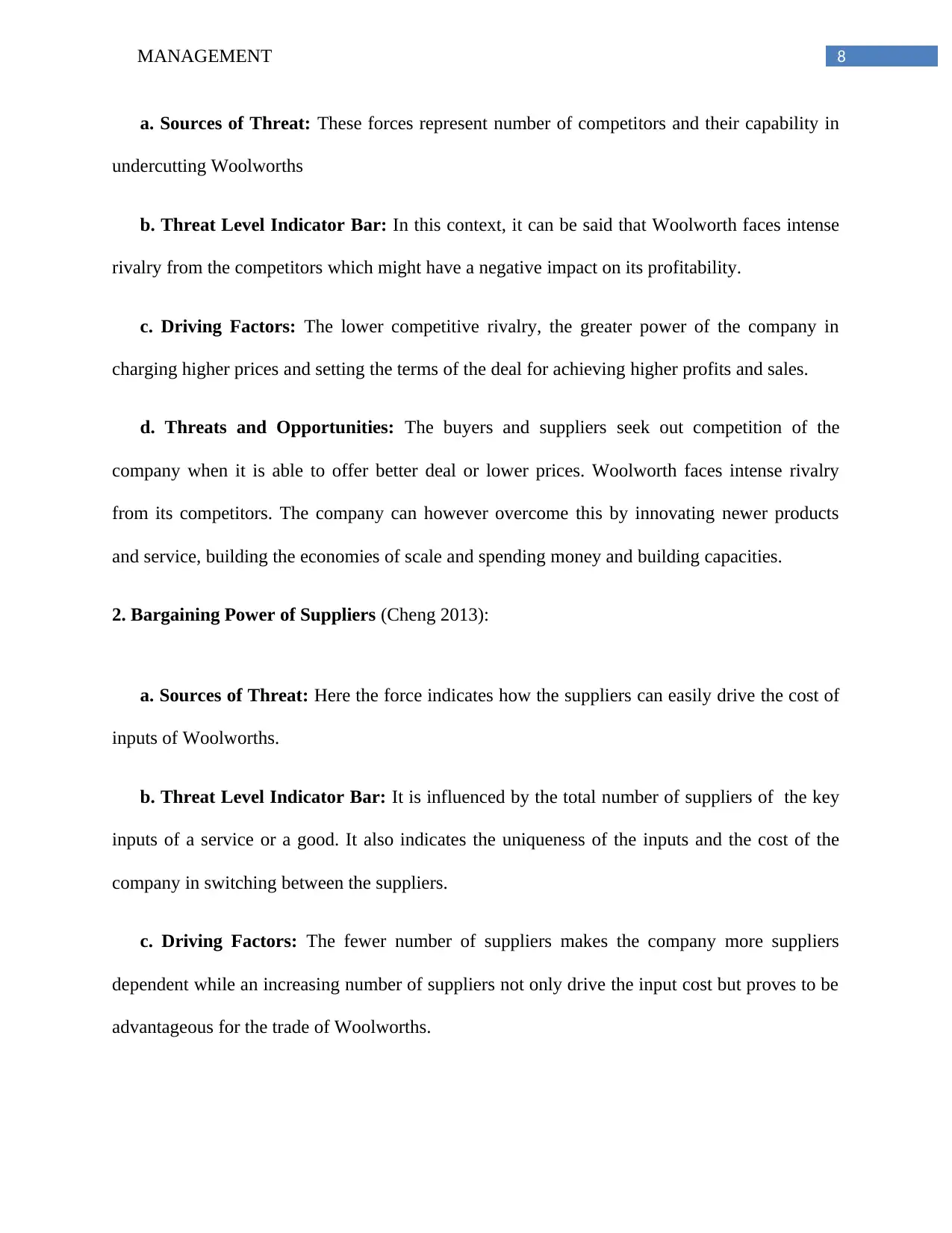
8MANAGEMENT
a. Sources of Threat: These forces represent number of competitors and their capability in
undercutting Woolworths
b. Threat Level Indicator Bar: In this context, it can be said that Woolworth faces intense
rivalry from the competitors which might have a negative impact on its profitability.
c. Driving Factors: The lower competitive rivalry, the greater power of the company in
charging higher prices and setting the terms of the deal for achieving higher profits and sales.
d. Threats and Opportunities: The buyers and suppliers seek out competition of the
company when it is able to offer better deal or lower prices. Woolworth faces intense rivalry
from its competitors. The company can however overcome this by innovating newer products
and service, building the economies of scale and spending money and building capacities.
2. Bargaining Power of Suppliers (Cheng 2013):
a. Sources of Threat: Here the force indicates how the suppliers can easily drive the cost of
inputs of Woolworths.
b. Threat Level Indicator Bar: It is influenced by the total number of suppliers of the key
inputs of a service or a good. It also indicates the uniqueness of the inputs and the cost of the
company in switching between the suppliers.
c. Driving Factors: The fewer number of suppliers makes the company more suppliers
dependent while an increasing number of suppliers not only drive the input cost but proves to be
advantageous for the trade of Woolworths.
a. Sources of Threat: These forces represent number of competitors and their capability in
undercutting Woolworths
b. Threat Level Indicator Bar: In this context, it can be said that Woolworth faces intense
rivalry from the competitors which might have a negative impact on its profitability.
c. Driving Factors: The lower competitive rivalry, the greater power of the company in
charging higher prices and setting the terms of the deal for achieving higher profits and sales.
d. Threats and Opportunities: The buyers and suppliers seek out competition of the
company when it is able to offer better deal or lower prices. Woolworth faces intense rivalry
from its competitors. The company can however overcome this by innovating newer products
and service, building the economies of scale and spending money and building capacities.
2. Bargaining Power of Suppliers (Cheng 2013):
a. Sources of Threat: Here the force indicates how the suppliers can easily drive the cost of
inputs of Woolworths.
b. Threat Level Indicator Bar: It is influenced by the total number of suppliers of the key
inputs of a service or a good. It also indicates the uniqueness of the inputs and the cost of the
company in switching between the suppliers.
c. Driving Factors: The fewer number of suppliers makes the company more suppliers
dependent while an increasing number of suppliers not only drive the input cost but proves to be
advantageous for the trade of Woolworths.
⊘ This is a preview!⊘
Do you want full access?
Subscribe today to unlock all pages.

Trusted by 1+ million students worldwide
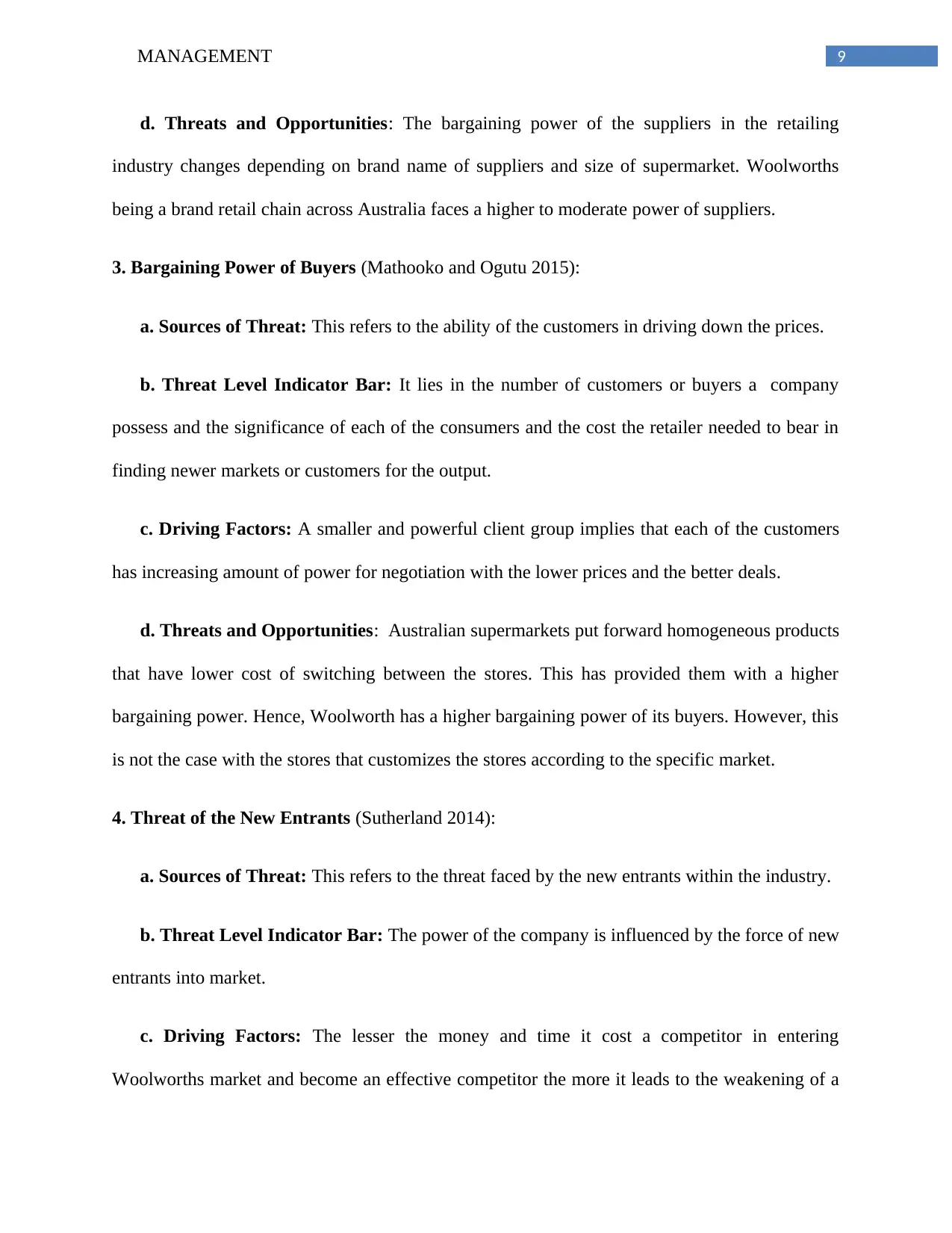
9MANAGEMENT
d. Threats and Opportunities: The bargaining power of the suppliers in the retailing
industry changes depending on brand name of suppliers and size of supermarket. Woolworths
being a brand retail chain across Australia faces a higher to moderate power of suppliers.
3. Bargaining Power of Buyers (Mathooko and Ogutu 2015):
a. Sources of Threat: This refers to the ability of the customers in driving down the prices.
b. Threat Level Indicator Bar: It lies in the number of customers or buyers a company
possess and the significance of each of the consumers and the cost the retailer needed to bear in
finding newer markets or customers for the output.
c. Driving Factors: A smaller and powerful client group implies that each of the customers
has increasing amount of power for negotiation with the lower prices and the better deals.
d. Threats and Opportunities: Australian supermarkets put forward homogeneous products
that have lower cost of switching between the stores. This has provided them with a higher
bargaining power. Hence, Woolworth has a higher bargaining power of its buyers. However, this
is not the case with the stores that customizes the stores according to the specific market.
4. Threat of the New Entrants (Sutherland 2014):
a. Sources of Threat: This refers to the threat faced by the new entrants within the industry.
b. Threat Level Indicator Bar: The power of the company is influenced by the force of new
entrants into market.
c. Driving Factors: The lesser the money and time it cost a competitor in entering
Woolworths market and become an effective competitor the more it leads to the weakening of a
d. Threats and Opportunities: The bargaining power of the suppliers in the retailing
industry changes depending on brand name of suppliers and size of supermarket. Woolworths
being a brand retail chain across Australia faces a higher to moderate power of suppliers.
3. Bargaining Power of Buyers (Mathooko and Ogutu 2015):
a. Sources of Threat: This refers to the ability of the customers in driving down the prices.
b. Threat Level Indicator Bar: It lies in the number of customers or buyers a company
possess and the significance of each of the consumers and the cost the retailer needed to bear in
finding newer markets or customers for the output.
c. Driving Factors: A smaller and powerful client group implies that each of the customers
has increasing amount of power for negotiation with the lower prices and the better deals.
d. Threats and Opportunities: Australian supermarkets put forward homogeneous products
that have lower cost of switching between the stores. This has provided them with a higher
bargaining power. Hence, Woolworth has a higher bargaining power of its buyers. However, this
is not the case with the stores that customizes the stores according to the specific market.
4. Threat of the New Entrants (Sutherland 2014):
a. Sources of Threat: This refers to the threat faced by the new entrants within the industry.
b. Threat Level Indicator Bar: The power of the company is influenced by the force of new
entrants into market.
c. Driving Factors: The lesser the money and time it cost a competitor in entering
Woolworths market and become an effective competitor the more it leads to the weakening of a
Paraphrase This Document
Need a fresh take? Get an instant paraphrase of this document with our AI Paraphraser
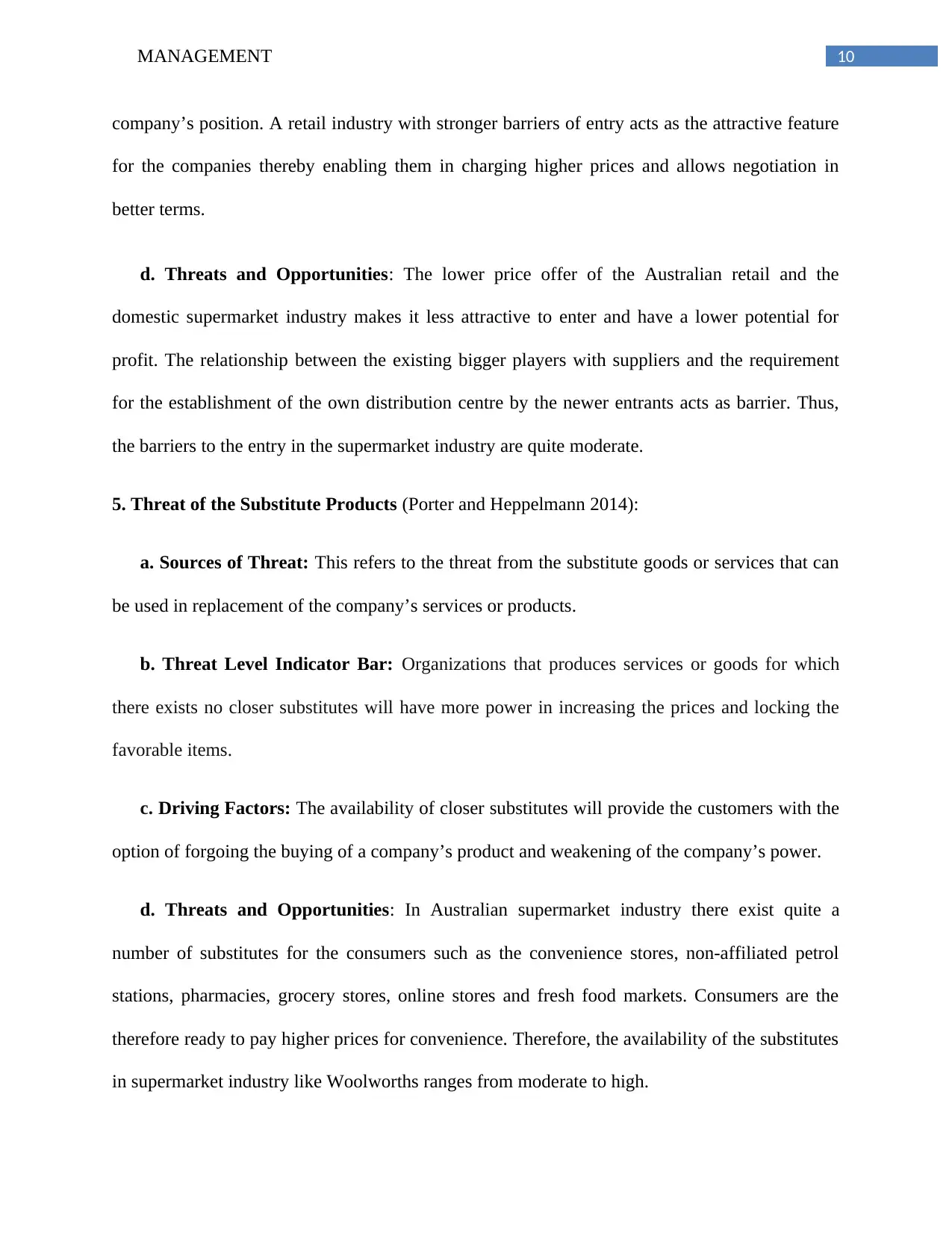
10MANAGEMENT
company’s position. A retail industry with stronger barriers of entry acts as the attractive feature
for the companies thereby enabling them in charging higher prices and allows negotiation in
better terms.
d. Threats and Opportunities: The lower price offer of the Australian retail and the
domestic supermarket industry makes it less attractive to enter and have a lower potential for
profit. The relationship between the existing bigger players with suppliers and the requirement
for the establishment of the own distribution centre by the newer entrants acts as barrier. Thus,
the barriers to the entry in the supermarket industry are quite moderate.
5. Threat of the Substitute Products (Porter and Heppelmann 2014):
a. Sources of Threat: This refers to the threat from the substitute goods or services that can
be used in replacement of the company’s services or products.
b. Threat Level Indicator Bar: Organizations that produces services or goods for which
there exists no closer substitutes will have more power in increasing the prices and locking the
favorable items.
c. Driving Factors: The availability of closer substitutes will provide the customers with the
option of forgoing the buying of a company’s product and weakening of the company’s power.
d. Threats and Opportunities: In Australian supermarket industry there exist quite a
number of substitutes for the consumers such as the convenience stores, non-affiliated petrol
stations, pharmacies, grocery stores, online stores and fresh food markets. Consumers are the
therefore ready to pay higher prices for convenience. Therefore, the availability of the substitutes
in supermarket industry like Woolworths ranges from moderate to high.
company’s position. A retail industry with stronger barriers of entry acts as the attractive feature
for the companies thereby enabling them in charging higher prices and allows negotiation in
better terms.
d. Threats and Opportunities: The lower price offer of the Australian retail and the
domestic supermarket industry makes it less attractive to enter and have a lower potential for
profit. The relationship between the existing bigger players with suppliers and the requirement
for the establishment of the own distribution centre by the newer entrants acts as barrier. Thus,
the barriers to the entry in the supermarket industry are quite moderate.
5. Threat of the Substitute Products (Porter and Heppelmann 2014):
a. Sources of Threat: This refers to the threat from the substitute goods or services that can
be used in replacement of the company’s services or products.
b. Threat Level Indicator Bar: Organizations that produces services or goods for which
there exists no closer substitutes will have more power in increasing the prices and locking the
favorable items.
c. Driving Factors: The availability of closer substitutes will provide the customers with the
option of forgoing the buying of a company’s product and weakening of the company’s power.
d. Threats and Opportunities: In Australian supermarket industry there exist quite a
number of substitutes for the consumers such as the convenience stores, non-affiliated petrol
stations, pharmacies, grocery stores, online stores and fresh food markets. Consumers are the
therefore ready to pay higher prices for convenience. Therefore, the availability of the substitutes
in supermarket industry like Woolworths ranges from moderate to high.
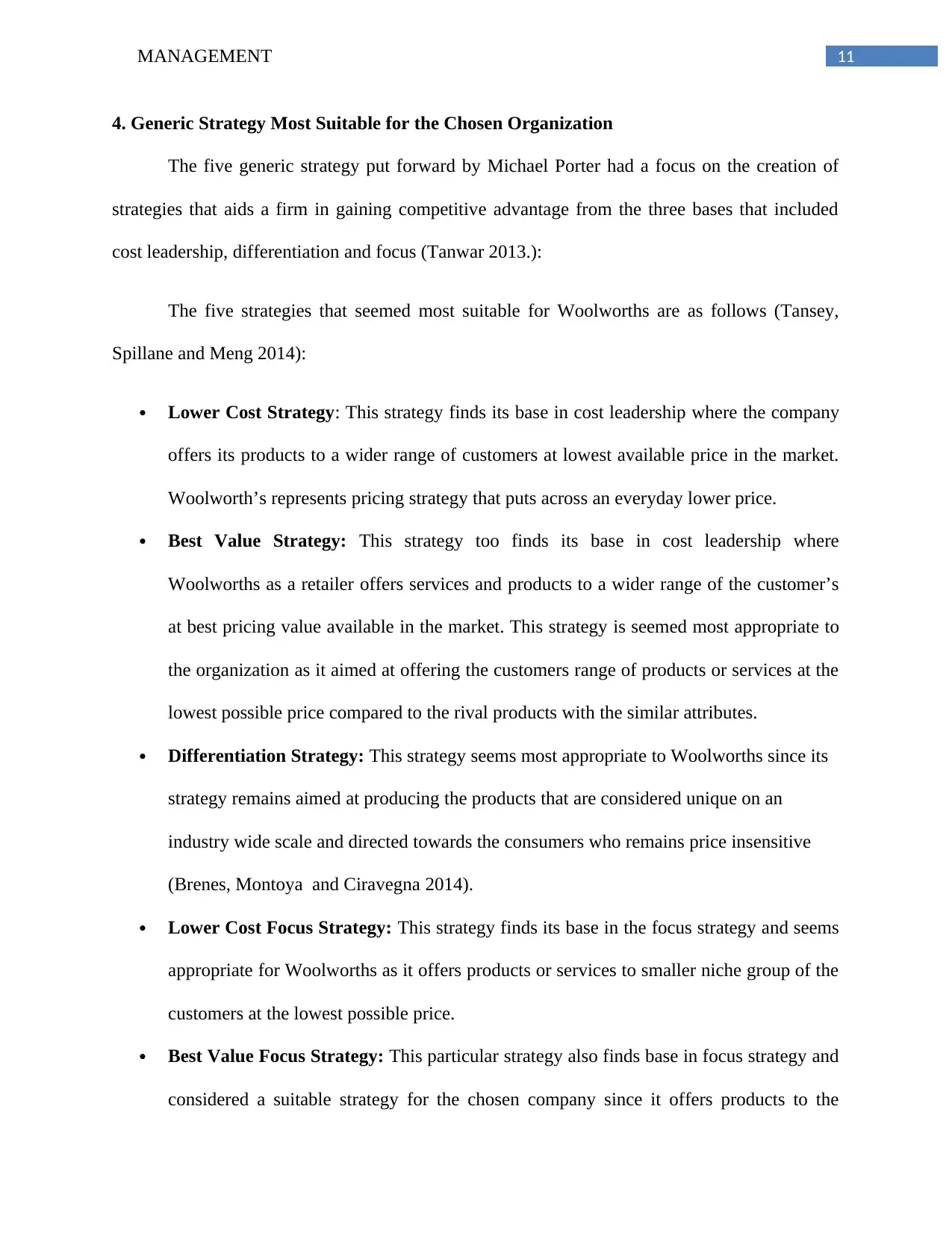
11MANAGEMENT
4. Generic Strategy Most Suitable for the Chosen Organization
The five generic strategy put forward by Michael Porter had a focus on the creation of
strategies that aids a firm in gaining competitive advantage from the three bases that included
cost leadership, differentiation and focus (Tanwar 2013.):
The five strategies that seemed most suitable for Woolworths are as follows (Tansey,
Spillane and Meng 2014):
Lower Cost Strategy: This strategy finds its base in cost leadership where the company
offers its products to a wider range of customers at lowest available price in the market.
Woolworth’s represents pricing strategy that puts across an everyday lower price.
Best Value Strategy: This strategy too finds its base in cost leadership where
Woolworths as a retailer offers services and products to a wider range of the customer’s
at best pricing value available in the market. This strategy is seemed most appropriate to
the organization as it aimed at offering the customers range of products or services at the
lowest possible price compared to the rival products with the similar attributes.
Differentiation Strategy: This strategy seems most appropriate to Woolworths since its
strategy remains aimed at producing the products that are considered unique on an
industry wide scale and directed towards the consumers who remains price insensitive
(Brenes, Montoya and Ciravegna 2014).
Lower Cost Focus Strategy: This strategy finds its base in the focus strategy and seems
appropriate for Woolworths as it offers products or services to smaller niche group of the
customers at the lowest possible price.
Best Value Focus Strategy: This particular strategy also finds base in focus strategy and
considered a suitable strategy for the chosen company since it offers products to the
4. Generic Strategy Most Suitable for the Chosen Organization
The five generic strategy put forward by Michael Porter had a focus on the creation of
strategies that aids a firm in gaining competitive advantage from the three bases that included
cost leadership, differentiation and focus (Tanwar 2013.):
The five strategies that seemed most suitable for Woolworths are as follows (Tansey,
Spillane and Meng 2014):
Lower Cost Strategy: This strategy finds its base in cost leadership where the company
offers its products to a wider range of customers at lowest available price in the market.
Woolworth’s represents pricing strategy that puts across an everyday lower price.
Best Value Strategy: This strategy too finds its base in cost leadership where
Woolworths as a retailer offers services and products to a wider range of the customer’s
at best pricing value available in the market. This strategy is seemed most appropriate to
the organization as it aimed at offering the customers range of products or services at the
lowest possible price compared to the rival products with the similar attributes.
Differentiation Strategy: This strategy seems most appropriate to Woolworths since its
strategy remains aimed at producing the products that are considered unique on an
industry wide scale and directed towards the consumers who remains price insensitive
(Brenes, Montoya and Ciravegna 2014).
Lower Cost Focus Strategy: This strategy finds its base in the focus strategy and seems
appropriate for Woolworths as it offers products or services to smaller niche group of the
customers at the lowest possible price.
Best Value Focus Strategy: This particular strategy also finds base in focus strategy and
considered a suitable strategy for the chosen company since it offers products to the
⊘ This is a preview!⊘
Do you want full access?
Subscribe today to unlock all pages.

Trusted by 1+ million students worldwide
1 out of 20
Related Documents
Your All-in-One AI-Powered Toolkit for Academic Success.
+13062052269
info@desklib.com
Available 24*7 on WhatsApp / Email
![[object Object]](/_next/static/media/star-bottom.7253800d.svg)
Unlock your academic potential
Copyright © 2020–2025 A2Z Services. All Rights Reserved. Developed and managed by ZUCOL.





